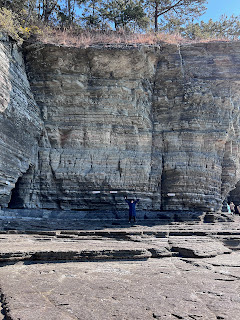I left Chuey at home and grabbed some other friends to try to walk the dinosaur tracks again. This time I was successful! Technically it is a natural reserve located near 덩명 Deongmyeong Village.
This area became known for the fossilized dinosaur footprints that were discovered in the coastal rock bed in 1982. More than 2,000 fossils of dinosaur prints have been found at 5 different sites along 6km of the coast.
The footprints are believed to have been formed about 100 million years ago during the early and mid-Cretaceous period. The prints do not pop out at ya in person, and they did not show up in pictures at all. You can see some holes in the middle of this picture. The sign said that because they are evenly spaced, it suggests the small plant-eating dinosaur traveled very slowly and peacefully towards the south.
I zoomed in on it. The little holes with water are the prints.
This site is recognized as one of the three largest dinosaur footprint fossil sites in the world, renowned for both the number and diversity of fossils. The footprints belong to 4-legged plant eaters, 2-legged plant eaters, and meat eaters; they belong to brontosaurus, brachiosaurus, allosaurus and baranosaurus, to name a few. The largest Mesozoic bird footprint is located here as well, but I can't tell you which one it is.
These small footprints are grouped together and suggest that they lived near this area because they are coming and going in different directions.
촡대바위 Chotdaebawi Rock stands out along the shore. These big rocks are called dykes and were created by the cooling of magma that penetrated upwards through existing rocks.
Geologists determined that these ripple marks were created by wave actions in the shallow lake.
I thought we would be able to walk the shoreline for a long way. But the trail stopped.A view of Chotdaebawi from farther away.People love to stack rocks. I always try to capture it, but pictures never do it justice. You can see just how many there are when you compare to the people near the stairs.
Inside this large rock behind the prints a cool erosion cave has formed, called 상족감 Sangjokgam. This is the other side. It is bigger than it first seems. You hardly notice me standing at the bottom.
The rocks are named after the table leg-shaped stones of the cave. If you have read some of my other posts over the past couple years, you know that there are many Korean folktales regarding the formation of many natural land marks. This particular one has to do with fairies coming down from heaven to the cave to weave clothes out of brocade for the King of Heaven. Whilst there they bathed in the pond in the cave called 선녀탕Seonnyeotang (Fairy Bath). It is said that the shape of a loom and a puddle still exist. I did see a puddle inside the cave, but I'm not so sure that it resembled a loom...
 |
| Trish, Laura and Nadine |
This cave was formed by continuous wave action on sedimentary rocks. Dinosaur footprints and ripple marks are on the floor of the cave. Two and a half years ago the kids and I ventured out to look for this. We ended up in the parking lot of the dinosaur museum; after wandering around the museum and the grounds we found this cave. The tide was in, so we didn't see as many footprints as I did today.This shell has somehow became embedded in the rock.
Two and a half years ago the kids and I ventured out to look for this. We ended up in the parking lot of the dinosaur museum; after wandering around the museum and the grounds we found this cave. The tide was in, so we didn't see as many footprints as I did today.This shell has somehow became embedded in the rock.
 Two and a half years ago the kids and I ventured out to look for this. We ended up in the parking lot of the dinosaur museum; after wandering around the museum and the grounds we found this cave. The tide was in, so we didn't see as many footprints as I did today.
Two and a half years ago the kids and I ventured out to look for this. We ended up in the parking lot of the dinosaur museum; after wandering around the museum and the grounds we found this cave. The tide was in, so we didn't see as many footprints as I did today.We got to go as far as 상족암선착장 Sangjogam Quay.
[February 25]






























No comments:
Post a Comment